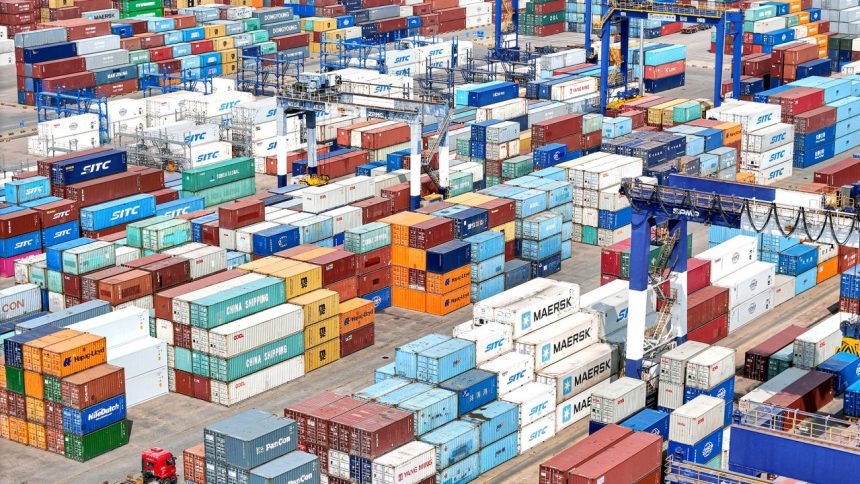Hong Kong
CNN
—
China said Friday that it will impose reciprocal 34% tariffs on all imports from the United States from April 10, making good on a promise to strike back after US President Donald Trump escalated a global trade war.
On Wednesday, Trump unveiled an additional 34% tariff on all Chinese goods imported into the US, in a move poised to cause a major reset of relations and worsen trade tensions between the world’s two largest economies.
“This practice of the US is not in line with international trade rules, seriously undermines China’s legitimate rights and interests, and is a typical unilateral bullying practice,” China’s State Council Tariff Commission said in a statement announcing its retaliatory tariffs.
Since returning to power in January, Trump had already levied two tranches of 10% additional duties on all Chinese imports, which the White House said was necessary to stem the flow of illicit fentanyl from the country to the US. Combined with pre-existing tariffs, that means Chinese goods arriving in the US would be effectively subject to tariffs well over 54%.
China’s retaliation against the latest round of US tariffs is more sweeping than its earlier reciprocal actions. Beijing had responded to previous levies swiftly but moderately, imposing retaliatory tariffs on targeted US imports, including agricultural products and fuel, while taking action against certain American firms and ramping up export controls.
The latest tariffs on Chinese goods are higher than what many analysts had expected and could fundamentally reshape relations, and roughly half a trillion dollars in trade, between the two economies after decades of interdependence.
As part of the retaliatory measures announced Friday, when hundreds of millions of people in China celebrated a major public holiday called the Tomb Sweeping Festival, the country also added 11 American companies to its “unreliable entity list,” including drone manufacturers, and put export controls on 16 American companies to prohibit the export of Chinese dual-use items.
The Commerce Ministry announced anti-dumping investigations into imported medical CT X-ray tubes originating from the US and India.
In addition, Beijing also unveiled export controls on seven types of rare-earth minerals to the US, including samarium, gadolinium and terbium.
US stock futures plunged Friday after China announced it would retaliate. Dow futures fell 1,000 points, or 2.3%. The broader S&P 500 was set to open 2.4% lower and the tech-heavy Nasdaq Composite was on pace to start the day 2.7% lower. European and UK stocks were down more than 3% Friday, on pace for their worst performance in years.
Markets have been on edge for days. On Thursday, the Dow fell more than 1,600 points, or nearly 4%. The S&P 500 fell nearly 5% and the Nasdaq plunged nearly 6%. Each major US index recorded its worst performance in about five years, since the pandemic.
US Secretary of State Marco Rubio acknowledged Friday that “markets are crashing” following the Trump administration’s launch of sweeping global tariffs, but claimed “the markets will adjust.”
“Businesses around the world, including in trade and global trade, they just need to know what the rules are. Once they know what the rules are, they will adjust to those rules,” Rubio told reporters at a meeting of NATO foreign ministers in Brussels.
A tough time
The challenges are now multifold for businesses with supply chains rooted in China, which are left scrambling as they face not only the unexpectedly high US levies on Chinese imports, but also on other Asian countries due to Trump’s broad-based tariffs.
The tariffs also come at a tough time for China’s own slowing economy, with officials in recent weeks ramping up efforts to spur weak domestic consumption as they braced for the widening trade war.
Larry Hu, chief China economist at Macquarie Group, wrote in a Thursday research note that Trump has effectively raised the average US tariff rate on Chinese products to 69%. That’s because the average rate on Chinese goods was already at 15% when Trump took office in January, he said.
Hu estimates that the current escalation could shave up to 2.5 percentage points off China’s economic growth for this year. China is aiming to grow its economy by around 5% in 2025.
“The impact could manifest itself through multiple channels such as falling US demand for Chinese goods, the potential global economic slowdown and the hit on export re-routing,” Hu wrote.
Export re-routing refers to the practice of exporting goods that were previously imported into a country to another place without significant processing. Countries in Southeast Asia and Latin America were part of this trend during Trump’s first term when China tried to mitigate the impact of tariffs imposed at that time.
This story has been updated with additional reporting and context.



